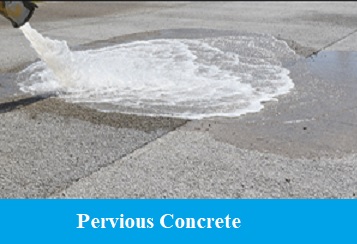It is a special type of concrete with a high porosity utilized for concrete flatwork applications that permits water from precipitation and other sources to pass directly through, thereby decreasing the runoff from a site and allowing groundwater recharge. Pervious Concrete is also known as porous concrete, permeable concrete, no-fines concrete, and porous pavement.
This type of concrete is produced using large aggregates with little to no fine aggregates. Thereafter, concrete paste coats the aggregates and permits water to pass through the concrete slab. Normally, it is used in pedestrians, walkways, and streets.

While Pervious concrete can be utilized for various applications, its essential use is in the pavement. Previous concrete focus s on the pavement applications of the material, which also has been referred to as porous concrete, permeable concrete, no-fines concrete, gap-graded concrete, and enhanced-porosity concrete.
Properties of Pervious Concrete
- Pervious concret comprises of concrete, coarse total (size should be 9.5 mm to 12.5 mm) and water with next to zero fine totals. The expansion of a limited quantity of sand will build the strength. The blend has a water-to-solidify proportion of 0.28 to 0.40 with a void substance of 15 to 25 percent.
- The right amount of water in the concrete is critical. Low water to solidify proportion will build the strength of the concrete, however too little water might cause surface failure. An appropriate water content gives the combination a wet-metallic appearance. As this concrete is touchy to water content, the combination ought to be field-checked.Entrained air might be estimated by a Rapid Air framework, where the concrete is stained dark and areas are investigated under a magnifying lens.
- A typical flatwork form has riser strips on top with the end goal that the screeds is 3/8-1/2 inches (9 to 12 mm) over the last asphalt height. Mechanical screeds are desirable over manual. The riser strips are eliminated to direct compaction. Following screeding, the concrete is compacted to work on the bond and smooth the surface. Unnecessary compaction of pervious concrete outcomes in higher compressive strength, yet lower porosity (and accordingly lower porousness).
- Jointing changes little from other concrete slabs. Joints are tooled with a rolling jointing apparatus before relieving or saw cut subsequent to restoring. Relieving comprises of covering concrete with 6 mils plastic sheeting inside 20 minutes of cement discharge. However, this adds to a significant measure of waste shipped off landfills. On the other hand, preconditioned absorptive lightweight total, as well as inside restoring admixture (ICA), have been utilized to successfully fix pervious concrete without waste production.
Advantages of Pervious Concrete:
- It is used to control runoff.
- It is used to decrease the size and number of storm sewers.
- It is used to recharge the groundwater.
- It is used to prevent the pollution of groundwater.
- It is used to eliminate the harm to sensitive ecosystems.
- It is used to decrease the heat island effect.
- It is used to increase land utilization by omitting the need for retention ponds.
- It is used to eliminate surface ponding.
- It is used to induce the heat-insulating properties in the walls of a building.
- It is used to enable easy plastering owing to its rough surface texture.
